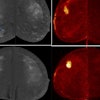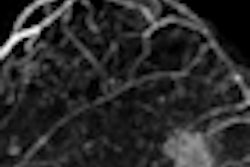
NEW YORK (Reuters Health) - Acute hyperglycemia, even without diabetes, raises the risk of contrast-induced nephropathy and death in patients with ST-elevation myocardial infarction (STEMI) undergoing percutaneous coronary angioplasty (PCI), new research shows.
In an observational study, acute hyperglycemia doubled the rate of contrast-induced nephropathy. And in-hospital mortality rose more than threefold when nephropathy followed hyperglycemia, the Italian researchers report in the December issue of the American Heart Journal.
The findings closely match a report earlier this year, in which rates of contrast injury rose as glucose levels increased in patients without diabetes who were having angiography for acute MI.
"These reports lead us to pay more attention to hyperglycemia's independent effect on (contrast-induced acute kidney injury) and to more tightly control each patient's blood glucose using standardized insulin protocols," Dr. Jeremiah R. Brown told Reuters Health. Dr. Brown, Assistant Professor of Health Policy and Clinical Practice at Dartmouth Medical School in Lebanon, NH, was not involved in the study.
The team at Centro Cardiologico Monzino at the University of Milan, led by Dr. Giancarlo Marenzi, examined the link between baseline glucose levels and in-hospital adverse events among 708 consecutive patients with STEMI who had primary PCI at their institution between 2003 and 2008. Clinicians used iomeprol, a nonionic, low-osmolality contrast agent during angiography.
At hospital admission, 19% of patients had acute hyperglycemia, defined as glucose levels above 198 mg/dL, and 14.5% developed contrast-induced nephropathy (creatinine increase > 25% from baseline value within 72 hours after PCI).
Contrast-induced nephropathy occurred in 27% of patients with acute hyperglycemia and in 12% with normoglycemia (p < 0.001). The difference was most marked among nondiabetics (38% versus 11%, respectively, p < 0.001), whereas the difference was not significant among those with preexisting diabetes (16% versus 29%, respectively).
Major adverse events -- shock, mechanical ventilation, continuous venovenous hemofiltration, atrial filtration and ventricular fibrillation -- were more frequent in the 40 patients with both acute hyperglycemia and contrast-induced nephropathy.
The mortality rate was also highest in this group at 38%, versus 22% in patients with only nephropathy, 3% in those with acute hyperglycemia only, and 0.5% in those with neither.
After adjusting for kidney function, diabetes, and contrast volume, the relative risk of in-hospital mortality was 3.39 (p < 0.001) in patients with contrast-induced nephropathy in the presence of acute hyperglycemia.
One theory behind these findings is that nephropathy and hyperglycemia simply denote a larger infarct size leading to hemodynamic compromise.
Then again, the authors posit, acute hyperglycemia increases oxidant stress and osmotic diuresis and decreases flow-mediated vasodilatation, which may exacerbate the vasoconstrictive response, renal medullary hypoxia and ischemia induced by a contrast medium.
Whatever the mechanism, Dr. Marenzi's team advises controlling acute hyperglycemia to prevent nephropathy in STEMI patients having PCI.
Dr. Brown makes a stronger point: "The likely solution is to reintroduce continuous insulin infusion and tight glycemic control protocols. The importance of these two reports demonstrates that uncontrolled hyperglycemia is a patient safety issue that will increase cost and patient morbidity if it is poorly managed."
Dr. Richard J. Solomon from the University of Vermont College of Medicine in Burlington, who also reviewed the research, commented to Reuters Health by e-mail that "it is not clear whether hyperglycemia is a pathophysiologic contributor to the kidney injury or simply a marker of the severity of the underlying cardiac status. Only a prospective randomized trial of different glycemic targets could resolve that question."
He noted that these patients are at high risk for contrast-induced nephropathy (occurring in 15% to 20% of patients undergoing PCI), because of the emphasis on opening the blocked coronary vessel as quickly as possible. "Given this short time span, preventative therapies for nephropathy are generally relegated to a secondary concern."
Dr. Solomon emphasized that many measures should be used to minimize the risk of kidney injury, starting with the least amount of contrast to diagnose the problem and open the culprit vessel.
"Intravenous fluid is administered to stimulate a high urine output and there is some evidence supporting the use of isotonic sodium bicarbonate as the IV fluid of choice (although not all studies have found this to be beneficial)," he continued. "Close attention to maintaining hemodynamic stability and avoidance of other nephrotoxic agents during and after the PCI are also standard of care."
By Karla Gale
Source: http://link.reuters.com/qys32r
Am Heart J 2010;160:1170-1177.
Last Updated: 2010-12-21 15:45:23 -0400 (Reuters Health)
Related Reading
N-acetylcysteine does not prevent contrast neuropathy, November 22, 2010
Contrast-induced nephropathy may be common after chest CT, October 1, 2010
Contrast-removal device may reduce CIN risk, September 13, 2010
ISCT speakers offer advice on managing CT contrast reactions, May 19, 2010
Copyright © 2010 Reuters Limited. All rights reserved. Republication or redistribution of Reuters content, including by framing or similar means, is expressly prohibited without the prior written consent of Reuters. Reuters shall not be liable for any errors or delays in the content, or for any actions taken in reliance thereon. Reuters and the Reuters sphere logo are registered trademarks and trademarks of the Reuters group of companies around the world.


















